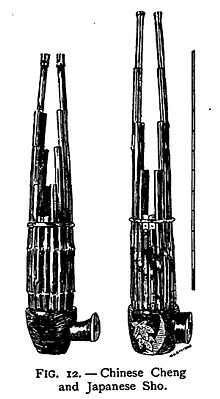Shō (instrument)

The shō (笙) is a Japanese free reed musical instrument that was introduced from China during the Nara period. It is modeled on the Chinese sheng, although the shō tends to be smaller in size. It consists of 17 slender bamboo pipes, each of which is fitted in its base with a metal free reed. Two of the pipes are silent, although research suggests that they were used in some music during the Heian period.
The instrument's sound is said to imitate the call of a phoenix, and it is for this reason that the two silent pipes of the shō are kept - as an aesthetic element, making two symmetrical "wings." Like the Chinese sheng, the pipes are tuned carefully with a drop of wax. As moisture collected in the shō's pipes prevents it from sounding, performers can be seen warming the instrument over a small charcoal brazier when they are not playing. The instrument produces sound when the player's breath is inhaled or exhaled, allowing long periods of uninterrupted play. The shō is one of the three primary woodwind instruments used in gagaku, Japan's imperial court music. Its traditional playing technique in gagaku involves the use of tone clusters called aitake, which move gradually from one to the other, providing accompaniment to the melody.
A larger size of shō, called ū (derived from the Chinese yu), is little used although some performers, such as Hiromi Yoshida, began to revive it in the late 20th century.
A detailed book in English on the sho and the gagaku (court orchestra music) it is associated with is titled "Music of A Thousand Autumns: the Togaku style of Japanese Court Music" by Robert Garfias.
Shō in contemporary music
The shō was first used as a solo instrument for contemporary music by the Japanese performer Mayumi Miyata. Mayumi and other shō players who specialize in contemporary music use specially constructed instruments whose silent pipes are replaced by pipes that sound notes unavailable on the more traditional instrument, giving a wider range of pitches.
Beginning in the mid-20th century, a number of Japanese composers have created works for the instrument, both solo and in combination with other Japanese and Western instruments. Most prominent among these are Toshi Ichiyanagi, Toru Takemitsu, Maki Ishii, Joji Yuasa, Toshio Hosokawa, and Minoru Miki.
The American composer John Cage (1912-1992) created a number of works for Mayumi just before his death, after having met her during the 1990 Darmstadt summer course.[1] Other notable contemporary performers, many of whom also compose for the shō and other instruments, include Hideaki Bunno (Japan), Tamami Tono (Japan), Hiromi Yoshida (Japan), Kō Ishikawa (Japan), Randy Raine-Reusch (Canada), and Sarah Peebles (Canada). Notable 20th century composers who studied the instrument in Japan include Benjamin Britten and Alan Hovhaness, the latter of whom composed two works for the instrument. German avant-garde composer Helmut Lachenmann used the shō at the climax of his opera, Das Mädchen mit den Schwefelhölzern. Otomo Yoshihide, Japanese experimental improv musician, incorporates the shō in some of his music.
The instrument was introduced to a wider audience in 2005 by Icelandic artist Björk, who used it as the primary instrument in three songs performed by Mayumi for the soundtrack album to Drawing Restraint 9, a film by her contemporary media artist boyfriend Matthew Barney, about Japanese culture and whaling.
Sho Another meaning in Japan
Recently in Japan, the word "Sho" has acquired a slang connotation, suggesting a person who is perceived to lack intelligence. Japanese children may use the word to insult another child who is sloppy or makes many mistakes. Although the word is not often heard, it is gradually becoming more common place. As a recent slang term, it may not appear in Japanese dictionaries. Because "Sho" is a common name in Japan, this slang usage may have originated from a group of people making fun of a person named "Sho" for appearing to be clumsy or unintelligent.
See also
External links
- History of the Free-Reed Instruments in Classical Music History and sound sample
- Columbia House Japan Photographs of modern-made instruments
- Randy Raine-Reusch's World Instrument Gallery Photograph and sound sample
